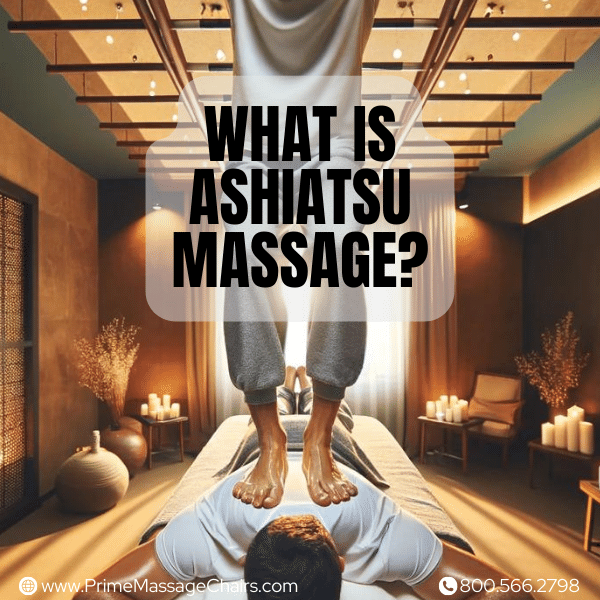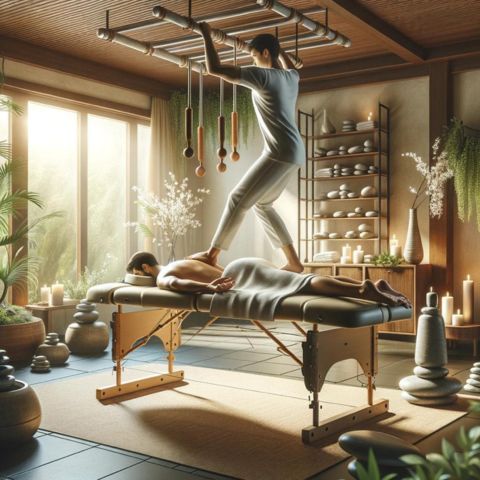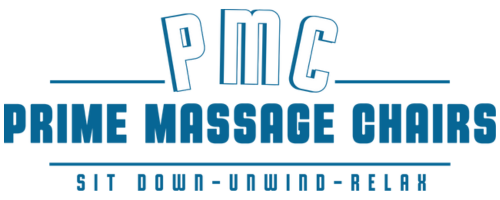
What is Ashiatsu Massage?
What is Ashiatsu massage? In a nutshell, it's a unique technique where therapists use their feet to deliver deep, soothing pressure.
This article will teach you about ashiatsu massage, from how it’s different from other massages to its potential benefits for your body and mind.
Keep reading to learn more.
Understanding Ashiatsu Massage
Ashiatsu massage brings a unique approach to deep tissue therapy.
Therapists use their feet to apply pressure, glide over muscles, and assist in stretching movements.

While some practitioners and recipients of Ashiatsu massage feel that the technique may allow for a different quality of pressure that could engage muscle fibers deeply, scientific research directly comparing Ashiatsu to traditional hand massage in terms of depth of muscle engagement is limited. Experiences and outcomes can vary among individuals.
The name itself comes from Japanese words "ashi" meaning foot and "atsu" meaning pressure, perfectly describing this powerful massage method.
Before starting, therapists discuss the patient's body needs and goals. They ensure the session is suited to individual preferences, aiming not to cause pain but to relieve it.
Typically performed on a specially designed massage table with the client lying face down, therapists often maintain balance using ceiling bars or ropes.
The control afforded by using bars or ropes may allow therapists to adjust pressure, which, similar to other forms of massage therapy, could contribute to pain reduction and improved flexibility.
However, the specific effectiveness of Ashiatsu in achieving these outcomes requires further research for confirmation.
Differences between Ashiatsu and Shiatsu Massage
Exploring the key differences between Ashiatsu and Shiatsu massage can provide insightful knowledge for those interested in understanding these unique massage therapies.
Below is a table highlighting their distinctive features.
| Aspect | Ashiatsu Massage | Shiatsu Massage |
|---|---|---|
| Pressure Application | Uses the practitioner's feet for deep pressure | Employs finger pressure for energy flow redirection |
| Technique Focus | Involves deep compression, long gliding strokes, and assisted stretching | Focuses on applying pressure to specific points on the body |
| Primary Benefit | Targets deep tissue, improving flexibility and reducing chronic pain | Aims to balance the body's energy flow for improved wellbeing |
| Experience | Highly physical, with emphasis on deep tissue relief | More gentle, focusing on holistic health balance |
This comparison highlights the fundamental distinctions between the two massage types, offering potential clients a clear understanding of what each therapy entails.
The Ashiatsu Massage Experience
During an Ashiatsu massage, therapists use their feet to apply deep and soothing pressure across your body.
This unique technique helps reach deeper layers of muscle and connective tissues, offering a level of intensity hard to achieve with traditional hands-on methods.
Massage tables support you comfortably as the therapist carefully balances themselves, using bars overhead for stability while delivering long, gliding strokes down the length of your muscles.
Clients often describe feeling both relaxed and invigorated after a session.
The process involves assisted stretching that improves flexibility and promotes better posture.
A pre-consultation ensures the treatment is tailored specifically to meet your needs and goals, making each therapy session a personalized experience aimed at reducing stress and chronic pain while enhancing overall well-being.
Top Benefits of Ashiatsu Massage
Massage therapy, including techniques like Ashiatsu, has been associated with benefits for body and mind, such as reduced pain and enhanced movement.

These benefits are consistent with findings on massage therapy in general, though individual experiences with Ashiatsu may vary.
Reduction of Chronic Pain
Ashiatsu massage therapy offers a unique solution for those battling chronic pain.
By employing deep compression and long gliding strokes, this barefoot massage technique effectively reduces discomfort.
It targets sore areas with precision, providing relief without causing additional pain.
The tailored approach ensures each session addresses the individual's specific needs, making it an ideal choice for lasting pain management, although individual results may vary.
Next up, we'll explore how ashiatsu massage can also enhance your flexibility.
Improved Flexibility
After addressing chronic pain, it's important to focus on how Ashiatsu massage promotes better movement.
This type of therapy uses deep compression and assisted stretching. These methods help a lot with making your body more flexible.
Massage therapists tailor the session to meet your needs, including specific stretches that make you looser.
You'll find yourself moving easier and enjoying a greater range of motion after just a few sessions.
This boost in flexibility is key for anyone wanting to maintain an active lifestyle without discomfort or restriction.
Deep Tissue Massage
Deep tissue massage goes deep into the muscles, targeting chronic pain and tightness.
It involves firm pressure and slow strokes to reach deeper layers of muscle and connective tissue.
This technique helps break up scar tissue that forms following an injury and reduce tension in muscle and tissue.
It also promotes faster healing by increasing blood flow and reducing inflammation.
Ashiatsu massage applies principles of deep tissue engagement in a unique way through the use of the therapist's feet, offering an alternative approach that some may find more effective for their specific needs.
The therapist uses their feet to apply more intense pressure than hands can achieve, making it a unique form of deep tissue massage.
This method allows for broader, deeper pressure without causing discomfort.
Ashiatsu not only relieves deep-seated tensions but also improves overall circulation, enhances flexibility, and supports mental health by providing profound relaxation.
Does Ashiatsu Massage Effects Last Longer?
The perception that Ashiatsu massage effects may last longer could be related to the deep pressure applied, which some recipients believe reaches far beneath the surface of the skin.
However, the duration of massage benefits, including those from Ashiatsu, can vary widely among individuals, and more research is needed to compare the longevity of effects across different massage types.
Practitioners of Ashiatsu suggest that the technique's intensity may be particularly effective in addressing muscle knots and tension for some clients, though effectiveness can vary and is subject to individual differences.
Because it goes deeper, ashiatsu stimulates blood and lymphatic flow throughout the body.
This boost to your circulation helps heal soreness and reduces inflammation for a long time after your session ends.
The unique approach of using feet is intended to allow therapists to apply a more substantial force, aiming to reach deep tissue layers while minimizing discomfort, according to client reports.
As a result, muscles stay relaxed longer, chronic pain lessens, and flexibility increases significantly.
Some recipients of Ashiatsu massage report feeling the benefits for an extended period, though individual experiences with the duration and extent of relief can vary.
Now let's take a look at some frequently asked questions about this powerful form of massage therapy.
FAQs
What is Ashiatsu massage?
Ashiatsu massage is a type of deep-tissue massage where the therapist uses their feet to apply pressure on trigger points along your spine and muscles.
How does Ashiatsu help with muscle pain?
By focusing on deep tissue, Ashiatsu can relieve chronic stress, shoulder pain, and improve muscle strength by working out knots and tension.
Is Ashiatsu similar to Swedish massage?
While both are types of therapeutic massages, Ashiatsu goes deeper than Swedish massage. It targets the structural integration of the body more intensely.
Can anyone get an Ashiatsu massage?
Most people can enjoy the benefits of an Ashiatsu massage; however, those with certain health conditions like pregnancy or recent surgery should consult a doctor first.
What makes Ashiatsu different from other massages?
The unique use of feet instead of hands allows for broader and deeper pressure without causing discomfort, making it effective for myofascial release and treating spine issues.
Where can I find an Ashiatsu massage therapist?
You can search online through network sites like Groupon or ask your local spa if they offer this service from certified therapists trained in this special technique.
Conclusion
Ashiatsu massage offers a unique approach to bodywork with its deep, soothing pressures.
By using the feet, therapists provide an experience unlike any traditional hand massage.
The technique focuses on pain relief and improved physical function, making it a standout choice for those seeking deep relaxation and healing.
With potential benefits like enhanced flexibility and stress reduction, this form of therapy stands out as a powerful tool in wellness.
It opens up new possibilities for managing chronic issues and promoting overall health.
Before scheduling an Ashiatsu massage session, it is advisable to consult with a healthcare provider, especially for individuals with existing health concerns or conditions.
Given the unique nature and intensity of Ashiatsu massage, it's strongly recommended to have a thorough consultation with a certified Ashiatsu therapist to assess your suitability for the technique, especially if you have underlying health conditions or concerns.
Disclaimer:
We do not provide medical advice. The content of this article, including text, graphics, and other material, is for informational purposes only. It is not intended to be a substitute for professional medical advice, diagnosis, or treatment. Always seek the advice of your physician or other qualified health provider with any questions you may have regarding a health condition. Never disregard professional medical advice or delay in seeking it because of something you have read in this article or on our website.
